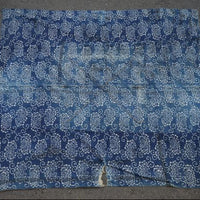
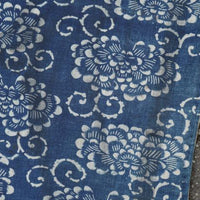
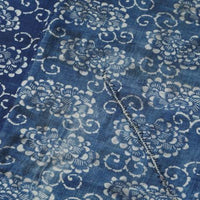

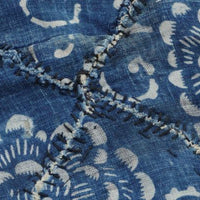


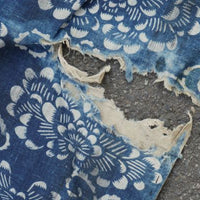

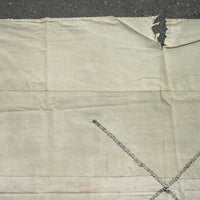
Antique Indigo Katazome Futon-ji – Chrysanthemum & Arabesque, 4 Panels Wide
A richly patterned antique textile with deep character and a life fully lived
This indigo-dyed cloth was once a futon-ji—a traditional Japanese futon cover pieced together from narrow handwoven cotton panels. Before factory-woven yardage became common, rural households wove cotton on small home looms that produced cloth only 13.5–14" wide (34–36 cm). Families then joined several panels edge-to-edge, creating large utilitarian textiles for bedding. The seams you see today are part of this quiet, practical history.
The design was created using katazome, a centuries-old resist-dye method in which artisans brush rice-flour paste through hand-cut stencils (katagami). Once the paste dries, the cloth is dipped into indigo vats. The resist prevents dye from penetrating certain areas, leaving the pattern light against the deep blue ground. This particular panel features chrysanthemum blossoms—an imperial motif in Japan symbolizing longevity—and scrolling arabesques, a pattern associated with protection, growth, and the natural movement of vines. Together, these motifs speak to good fortune, durability, and everyday beauty.
Because futon-ji were used daily, they often show layers of repair. In Japanese households, well-made cloth was never discarded; instead, it was patched, strengthened, and handed down. This one displays substantial visible mending, including a dramatic X-shaped hand-stitched repair at the center worked in thick, contrasting thread. These repairs are prized by textile enthusiasts today, representing the Japanese ethos of mottainai—nothing wasted, everything valued.
This piece also carries the honest markings of time: discoloration, scratches, and areas of staining—including what may be blood staining (common in household textiles of this age). These marks are part of the cloth’s human story. The back retains some fuzzy cotton batting from its former use as a futon-cover lining, a typical feature of antique pieces.
This futon-ji is compelling as a whole cloth for display, draped over furniture, or hung as wall art. It may also be thoughtfully cut for boro-inspired patchwork, visible mending, quilting, or textile study.
Age & Historical Context
This textile is considered antique, likely dating to the late Meiji (1868–1912) through early Shōwa period (1926–1989). We make this estimate based on:
-
the handwoven cotton typical of pre-war rural production
-
the katazome technique using traditional stencil motifs
-
the thickness and style of repair thread
-
the natural indigo dyeing visible in unevenness of tone
-
the presence of original batting adhered to the back
While the exact year cannot be confirmed, these characteristics strongly align with futon-ji produced in the early 20th century.
Dimensions: 51" × 57.5" (130 × 146 cm)
4 panels wide — calculated from the standard 13.5–14" loom width, minus seam allowances, which corresponds to the measured 51" total width.
Made in Japan










